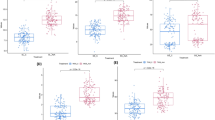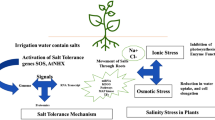Abstract
Durum wheat, Triticum turgidum L. (2n= 4x=28, genome formula AABB) is inferior to bread wheat, T. aestivum L. (2n=6x=42, genome formula AABBDD), in the ability to exclude Na+ under salt strees, in the ratio of the accumulated K+ to Na+ in the leaves under salt stress, and in tolerance of salt stress. Previous work showed that chromosome 4D has a major effect on Na+ and K+ accumulation in the leaves of bread wheat. The 4D chromosome was recombined with chromosome 4B in the genetic background of durum wheat. The recombinants showed that Na+ exclusion and enhanced K+/Na+ ratio in the shoots were controlled by a single locus, Kna1, in the long arm of chromosome 4D. The recombinant families were grown in the field under non-saline conditions and two levels of salinity to determine whether Kna1 confers salt tolerance. Under salt stress, the Kna1 families had higher K+/Na+ ratios in the flag leaves and higher yields of grain and biomass than the Kna1 - families and the parental cultivars. Kna1 is, therefore, one of the factors responsible for the higher salt tolerance of bread wheat relative to durum wheat. The present work provides conceptual evidence that tolerance of salt stress can be transferred between species in the tribe Triticeae.
Similar content being viewed by others
References
Dvořák J, Gorham J (1992) Methodology of gene transfer by homoeologous recombination into Triticum turgidum: transfer of K+/Na+ discrimination from Triticum aestivum. Genome 35:639–646
Epstein E (1973) Mechanisms of ion transport through plant cell membranes. Int Rev Cytol 34:123–168
Epstein E, Rains DW, Elzam OE (1963) Resolution of dual mechanisms of potassium absorption by barley roots. Proc Natl Acad Sci USA 49:684–692
Giorgi B, Cuozzo L (1980) Homoeologous pairing in a Ph mutant of tetraploid wheat crossed with rye. Cereal Res Commun 8:485–590
Gorham, J, McDonnell E, Budrewicz E, Wyn Jones RG (1985) Salt tolerance in the Triticeae: Growth and solute accumulation in leaves of Thinopyrum bessarabicum. J Exp Bot 36:1021–1031
Gorham J, Hardy C, Wyn Jones RG, Joppa LR, Law CN (1987) Chromosomal location of a K/Na discrimination character in the D genome of wheat. Theor Appl Genet 74:584–588
Hafez A, Goyal SS, Rains DW (1992) Simultaneous determination of sodium, potassium, magnesium and calcium in plant tissues using single column ion chromatography. In: Agronomy abstracts. ASA, Madison, Wis., p 279
Hart G, Langston PJ (1977) Chromosomal location and evolution of isozyme structural genes in hexaploid wheat. Heredity 39:263–277
Joppa LR, Williams ND (1988) ‘Langdon’ durum disomic substitution lines and aneuploid analysis in tetraploid wheat. Genome 30:222–228
Knott DR, Dvořák J (1976) Alien germplasm as a source of resistance to disease. Annu Rev Phytopathol 14:211–235
Omielan JA, Epstein E, Dvořák J (1991) Salt tolerance and ionic relations of wheat as affected by individual chromosomes of salt-tolerant Lophopyrum elongatum. Genome 34:961–974
SAS Institute (1985) SAS user's guide: statistics version. SAS Institute Inc, Cary. NC
Schachtman DP, Bloom AJ, Dvořák J (1989) Salt-tolerant Triticum x Lophopyrum derivatives limit accumulation of sodium and chloride ions under saline-stress. Plant Cell Environ 12:47–55
Sears ER (1974) Agropyron-wheat transfers induced by homoeologous recombination. In: Sears ER, Sears LMS (eds) Proc 4th Int Wheat Genet Symp. University of Missouri, Columbia, Mo., pp 191–199
Shah SH, Gorham J, Forster BP, Wyn Jones RG (1987) Salt tolerance in Triticeae: The contribution of the D genome to cation selectivity in hexaploid wheat. J Exp Bot 38:254–269
Storey R, Graham RD, Shepherd KW (1985) Modification of the salinity response of wheat by genome of Elytrigia elongatum. Plant Soil 83:327–330
Author information
Authors and Affiliations
Additional information
Communicated by G. E. Hart
Rights and permissions
About this article
Cite this article
Dvořak, J., Noaman, M.M., Goyal, S. et al. Enhancement of the salt tolerance of Triticum turgidum L. by the Kna1 locus transferred from the Triticum aestivum L. chromosome 4D by homoeologous recombination. Theoret. Appl. Genetics 87, 872–877 (1994). https://doi.org/10.1007/BF00221141
Received:
Accepted:
Issue Date:
DOI: https://doi.org/10.1007/BF00221141




